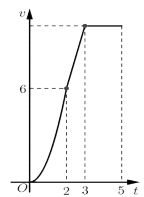Tìm hàm số F(x) biết F′(x)=3x2+2x−1 và đồ thị hàm số y=F(x) cắt trục tung tại
điểm có tung độ bằng 2. Tổng các hệ số của F(x) là:
Ta có: F′(x)=3x2+2x−1⇒F(x)=∫F′(x)dx=∫(3x2+2x−1)dx=x3+x2−x+C
Tại x=0 thì y=2 suy ra 2=C⇒F(x)=x3+x2−x+2 và tổng các hệ số của F(x) là 3.
Cho hàm số y=f(x) thỏa mãn f(2)=−419 và f′(x)=x3f2(x)∀x∈R. Giá trị của f(1) bằng:
Theo bài ra ta có: f′(x)=x3f2(x)∀x∈R⇔f′(x)f2(x)=x3∀x∈R.
Lấy nguyên hàm hai vế ta có: ∫f′(x)f2(x)dx=∫x3dx ⇔−1f(x)=x44+C.
Lại có: f(2)=−419⇔−1f(2)=4+C⇔194=4+C ⇔C=34.
Do đó −1f(x)=x44+34.
Thay x=1 ta có −1f(1)=14+34=1. Vậy f(1)=−1.
Họ nguyên hàm của hàm số y=2x+32x2−x−1 là:
2x+32x2−x−1=2x+3(2x+1)(x−1)
Do đó, ta cần biến đổi 2x+32x2−x−1=a2x+1+bx−1 để tính được nguyên hàm.
Ta có:
a2x+1+bx−1=a(x−1)+b(2x+1)(2x+1)(x−1)=ax−a+2bx+b(2x+1)(x−1)=(a+2b)x−a+b(2x+1)(x−1)
⇒2x+32x2−x−1=(a+2b)x−a+b(2x+1)(x−1)⇔{a+2b=2−a+b=3⇔{a=−43b=53
Do đó:
∫2x+32x2−x−1dx=∫[−43.1(2x+1)+53.1(x−1)]dx=−43∫1(2x+1)dx+53∫1(x−1)dx=−43.12ln|2x+1|+53ln|x−1|+C=−23ln|2x+1|+53ln|x−1|+C
Hàm số nào sau đây không là nguyên hàm của hàm sốf(x)=x(x+2)(x+1)2?
Đáp án B: x2−x−1x+1=x2−(x+1)x+1=x2x+1−1
Đáp án C: x2+x+1x+1=x2+(x+1)x+1=x2x+1+1
Đáp án D: x2x+1
Như thế, các hàm số ở ý B, C, D hơn kém nhau một số đơn vị do nên chúng là nguyên hàm của cùng một hàm số.
Một đám vi trùng tại ngày thứ t có số lượng N(t), biết rằng N′(t)=40001+0,5t và lúc đầu đám vi trùng có 250000 con. Hỏi số lượng vi trùng tại ngày thứ 10 (lấy theo phần nguyên) là bao nhiêu?
Ta có: N(t)=∫N′(t)dt=∫40000,5t+1dt=40000,5ln|0,5t+1|+C=8000ln|0,5t+1|+C.
Với t=0 thì 250000=8000ln1+C⇔C=250000.
Vậy N(t)=8000ln|0,5t+1|+250000⇒N(10)≈264334
Cho hàm số f(x) xác định và liên tục trên R và thỏa mãn đồng thời các điều kiện sau
f(x)>0;f′(x)=x.f(x)√x2+1;∀x∈R và f(0)=e. Giá trị của f(√3) bằng
Ta có f′(x)=x.f(x)√x2+1⇔f′(x)f(x)=x√x2+1⇔∫f′(x)f(x)dx=∫x√x2+1dx
⇔∫d(f(x))f(x)=∫d(x2+1)2√x2+1=√x2+1+C⇔lnf(x)=√x2+1+C⇔f(x)=e√x2+1+C
Mà f(0)=e⇒eC+1=e⇒C=0.
Vậy f(√3)=e2.
Cho hàm số f(x) liên tục trên R thỏa mãn các điều kiện: f(0)=2√2, f(x)>0,∀x∈R và f(x).f′(x)=(2x+1)√1+f2(x),∀x∈R. Khi đó giá trị f(1) bằng
Ta có: f(x).f′(x)=(2x+1)√1+f2(x)
⇒f(x).f′(x)√1+f2(x)=2x+1⇒∫f(x).f′(x)√1+f2(x)dx=∫(2x+1)dx
Tính ∫f(x).f′(x)√1+f2(x)dx ta đặt √1+f2(x)=t⇒1+f2(x)=t2⇒2f(x)f′(x)dx=2tdt ⇒f(x)f′(x)dx=tdt
Thay vào ta được ∫f(x).f′(x)√1+f2(x)dx=∫tdtt=∫dt=t+C=√1+f2(x)+C
Do đó √1+f2(x)+C=x2+x.
f(0)=2√2⇒√1+(2√2)2+C=0⇔C=−3.
Từ đó:
√1+f2(x)−3=x2+x⇒√1+f2(1)−3=1+1⇔√1+f2(1)=5⇔1+f2(1)=25⇔f2(1)=24⇔f(1)=√24
Đề thi THPT QG - 2021 - mã 101
Cho hàm số f(x)=x2+4. Khẳng định nào dưới đây đúng?
∫(x2+4)dx=x33+4x+C.
Đề thi THPT QG - 2021 - mã 101
Cho hàm số f(x)=ex+2. Khẳng định nào dưới đây đúng?
Ta có ∫(ex+2)dx=ex+2x+C.
Tìm họ nguyên hàm của hàm số f(x)=x2−2x+1x−2
Ta có f(x)=x2−2x+1x−2=x+1x−2.
⇒∫f(x)dx=∫(x+1x−2)dx=∫xdx+∫1x−2dx=x22+ln|x−2|+C.
Một chiếc xe đua F1 đạt tới vận tốc lớn nhất là 360km/h. Đồ thị bên biểu thị vận tốc v của xe trong 5 giây đầu tiên kể từ lúc xuất phát. Đồ thị trong 2 giây đầu là một phần của một parabol định tại gốc tọa độ O, giây tiếp theo là đoạn thẳng và sau đúng ba giây thì xe đạt vận tốc lớn nhất. Biết rằng mỗi đơn vị trục hoành biểu thị 1 giây, mỗi đơn vị trực tung biểu thị 10 m/s và trong 5 giây đầu xe chuyển động theo đường thẳng. Hỏi trong 5 giây đó xe đã đi được quãng đường là bao nhiêu?

Trong 2 giây đầu, v1=at2, lại có khi t=2(s)⇒v1=60(m/s) nên 60=a.22⇔a=15, suy ra v1=15t2.
Quãng đường vật đi được trong 2 giây đầu là s1=2∫0v1(t)dt=2∫015t2dt=40(m).
Trong giây tiếp theo, v2=mt+n.
Ta có {t=2⇒v=60t=3⇒v=360km/h=100m/s, nên ta có hệ phương trình {2m+n=603m+n=100⇔{m=40n=−20 ⇒v2(t)=40t−20.
Quãng đường vật đi được trong giây tiếp theo là s2=3∫2v2(t)dt=3∫2(40t−20)dt=80(m).
Trong 2 giây cuối, v3=100(m/s).
Quãng đường vật đi được trong 2 giây cuối là s3=5∫3v3(t)dt=5∫3100dt=200(m).
Vậy trong 5 giây đó xe đã đi được quãng đường là: 40+80+200=320(m).

